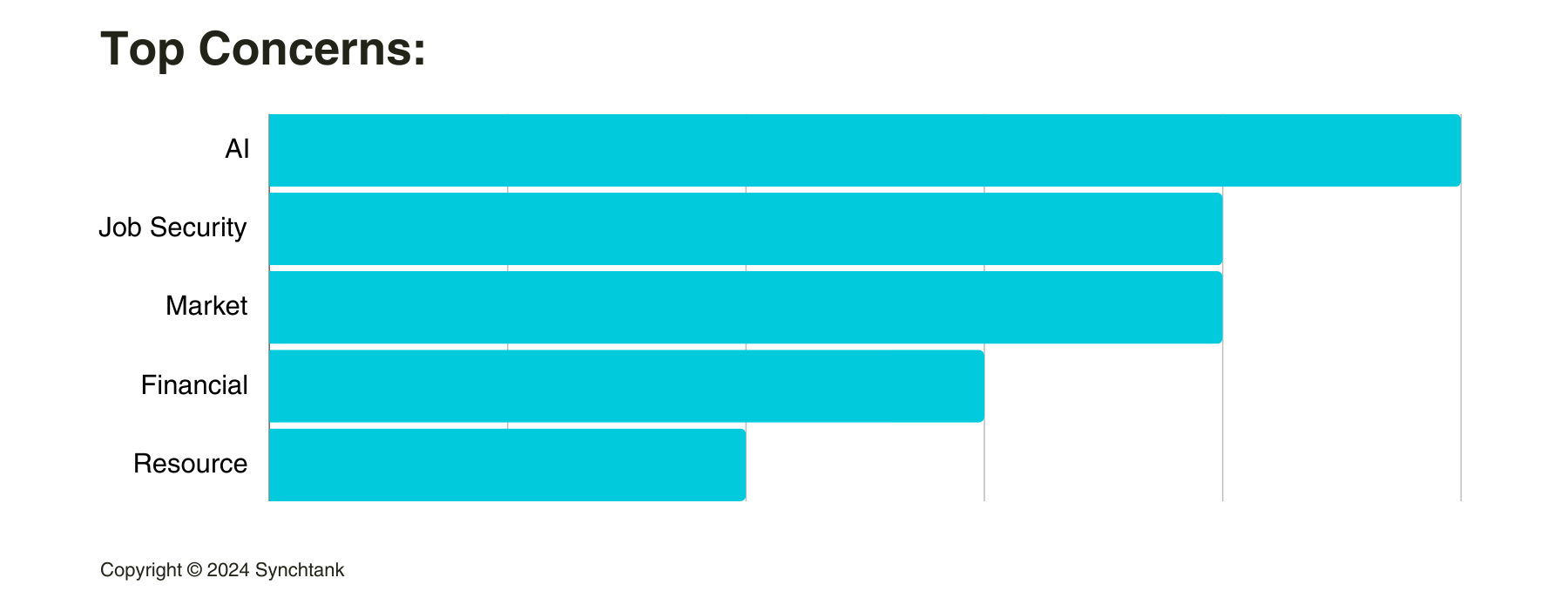This year, we set out to uncover the pulse of music usage in the media and broadcast industries. From emerging trends to pressing challenges and the groundbreaking technologies set to redefine the landscape, we’re diving deep into what’s next for the music-media connection.
To get the real story, we went straight to the experts—music teams at leading broadcasters, networks, and video game organizations. Whether they’re solo trailblazers or part of multinational powerhouses, their insights reveal the dynamics shaping the future of music in media.
Inside the Challenges of Music Supervision: Navigating a Dynamic and Demanding Landscape
Music supervisors and licensing professionals are at the heart of a fast-moving industry, juggling licenses, payments, and complex collaborations. Their days are a whirlwind of adapting to shifting production demands and ensuring smooth rights clearances. But what are the biggest hurdles they face?
Here’s what we uncovered:
- Tech Transformation Worries: While technological advancements bring efficiency, there’s rising concern about job displacement and the implications of evolving music rights legislation.
- Communication Roadblocks: A recurring frustration: unresponsive publishers and labels. Tight production deadlines demand quick turnarounds, yet slow responses add stress to already overburdened teams.
- Budget Squeezes: Producers pushing for alternate tracks and lower sync fees create significant challenges. Meanwhile, stagnant music budgets clash with rising rights demands, leaving supervisors to bridge the gap.
- Expanding Rights Requirements: The scope of music rights requests continues to grow, but the resources to meet these demands haven’t kept pace, piling on additional pressure.
These insights reveal a tough, yet resilient, industry—one where adaptability is key and collaboration remains crucial to overcoming obstacles.
The Double-Edged Sword of Technology: Revolutionizing Music Licensing in Media and Broadcast
Technology is undeniably reshaping the music licensing landscape, offering tools to simplify rights management and improve efficiency. This year, it’s been a hot topic at music and media conferences worldwide. But what’s the real sentiment toward these advancements within media and broadcast teams? Here’s what we uncovered:
The Fast Pace of Change
The rapid evolution of technology demands that music teams adopt new platforms to keep up. Unsurprisingly, no discussion about tech today is complete without mentioning AI and blockchain, which are quickly becoming industry buzzwords.
AI: A Blend of Excitement and Fear
AI offers groundbreaking solutions, such as audio recognition that leverages metadata and automates cue sheet creation. These innovations promise to ease workloads and boost accuracy. But they also spark fears about job displacement, raising questions about the future of clearance roles and other traditional tasks.
The Dilemma of Efficiency vs. Security
Technology has the power to streamline overwhelming workloads, making it highly attractive to executives and management. However, for those entrenched in manual processes, concerns about losing control—or even their jobs—are completely valid.
An Industry at a Crossroads
As tech continues to transform workflows, the music and broadcast industries find themselves facing critical questions: How can we balance efficiency with job security? Will these advancements redefine roles in music departments?
The road ahead is uncertain but exciting. As we embrace the possibilities of technology, the industry must also prioritize reshaping itself to empower professionals and ensure a future where human expertise and innovation coexist seamlessly.
The Growing Value of TV Sync: A Launchpad for Marketing Artists and Songs
The evolving media landscape is unlocking exciting opportunities for new deal-making strategies and expanding the use of commercial music in broadcasts. Here’s how the industry is adapting to changing dynamics:
Sync as a Strategic Powerhouse
With rising awareness of TV sync’s potential, artists and their songs are finding a powerful platform for exposure and marketing. Experts note that this shift is creating fertile ground for innovative partnerships and creative deals.
A Post-Strike Recovery Boosts Production Music
Although recovery from recent industry strikes has been gradual, one area thriving is production music. According to MIDiA Research, production music revenue is projected to hit $1.3 billion in 2024. Respondents shared that production music often serves as a time-efficient, budget-friendly alternative to original scores or high-cost commercial tracks.
Cultural Shifts in Media Consumption
The strike period accelerated changes in how audiences consume content. As a Forbes article highlighted earlier this year, viewers are increasingly turning to digital platforms and streaming services for content. Our experts echoed this, emphasizing the need for adaptable marketing and advertising strategies to stay profitable in this shifting ecosystem.
Optimism Amid Industry Challenges
Despite layoffs and economic pressures, there’s hope for continued demand for music in new TV seasons and productions. Notably, the creative reins at larger companies are being handed back to individual creators, signaling a move toward more inclusive and diverse creative practices.
Opportunities in a Complex Landscape
The music industry is navigating a crossroads of technological innovation, shifting consumer habits, and economic hurdles. But with these challenges come fresh opportunities to reshape the way music is used, marketed, and integrated into media.
As TV sync continues to gain momentum, the future promises a dynamic mix of creativity, collaboration, and cultural impact. The question is: How will the industry seize these opportunities to redefine success in 2024 and beyond?
The Future of Music Tech: Where Dreams Meet Reality
Let’s be honest—navigating the maze of music clearance can feel like trying to untangle headphones from the bottom of your bag. So, we asked the experts: What would the perfect tech solution look like for media and broadcast music teams? Spoiler alert—it’s a game-changer.
Smart, Savvy Metadata and Audio Recognition
Say goodbye to mismatched data! The dream platform would nail accurate metadata and recognize audio like a pro, cutting out the guesswork and saving you from endless back-and-forths.
Plugged Into the Platforms You Love
Picture this: cue sheets and ISWCs magically synced with Spotify, YouTube, and Netflix. It’s integration on steroids, making life easier for broadcasters juggling multimedia projects.
A One-Stop Shop for Music Rights
All your music copyright info in one place? Yes, please. A centralized hub that’s always up-to-date, always accurate, and ready to roll whenever you are.
End-to-End Magic
From music requests to clearance, licensing, and cue sheets—it’s all handled seamlessly in one slick portal. No more jumping between tools or losing track of where you’re at.
Now here’s the fun part: That dream platform? It already exists. Synchtank’s platform is the Swiss Army knife of music rights management, turning the chaos into a smooth ride.
So, if your workflow needs a glow-up, it’s time to ditch the frustrations and embrace the tech of tomorrow—because the future of music clearance is here, and it’s looking very exciting!


